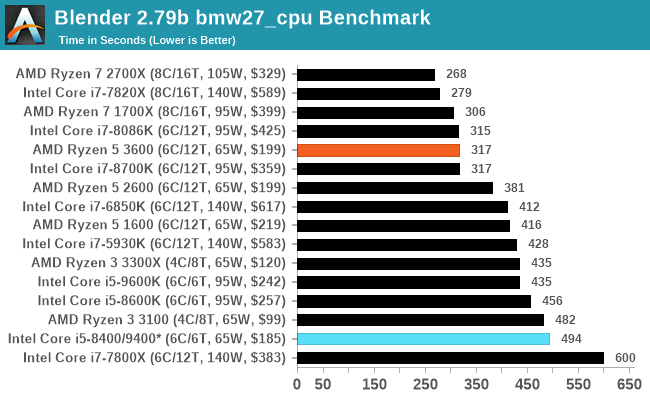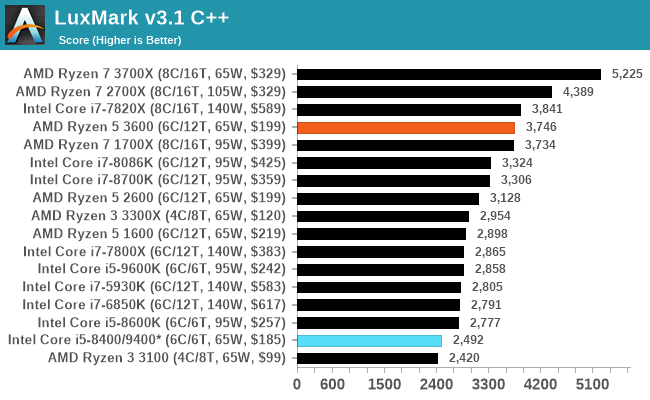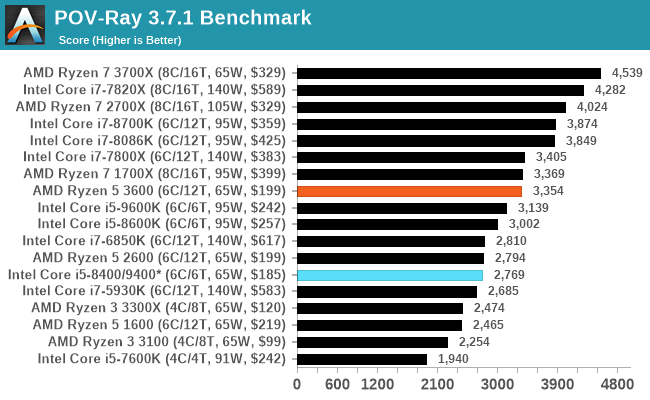AMD Ryzen 5 3600 Review: Why Is This Amazon's Best Selling CPU?
by Dr. Ian Cutress on May 18, 2020 9:00 AM ESTCPU Performance: Rendering Tests
Rendering is often a key target for processor workloads, lending itself to a professional environment. It comes in different formats as well, from 3D rendering through rasterization, such as games, or by ray tracing, and invokes the ability of the software to manage meshes, textures, collisions, aliasing, physics (in animations), and discarding unnecessary work. Most renderers offer CPU code paths, while a few use GPUs and select environments use FPGAs or dedicated ASICs. For big studios however, CPUs are still the hardware of choice.
All of our benchmark results can also be found in our benchmark engine, Bench.
Corona 1.3: Performance Render
An advanced performance based renderer for software such as 3ds Max and Cinema 4D, the Corona benchmark renders a generated scene as a standard under its 1.3 software version. Normally the GUI implementation of the benchmark shows the scene being built, and allows the user to upload the result as a ‘time to complete’.
We got in contact with the developer who gave us a command line version of the benchmark that does a direct output of results. Rather than reporting time, we report the average number of rays per second across six runs, as the performance scaling of a result per unit time is typically visually easier to understand.
The Corona benchmark website can be found at https://corona-renderer.com/benchmark

Blender 2.79b: 3D Creation Suite
A high profile rendering tool, Blender is open-source allowing for massive amounts of configurability, and is used by a number of high-profile animation studios worldwide. The organization recently released a Blender benchmark package, a couple of weeks after we had narrowed our Blender test for our new suite, however their test can take over an hour. For our results, we run one of the sub-tests in that suite through the command line - a standard ‘bmw27’ scene in CPU only mode, and measure the time to complete the render.
Blender can be downloaded at https://www.blender.org/download/

LuxMark v3.1: LuxRender via Different Code Paths
As stated at the top, there are many different ways to process rendering data: CPU, GPU, Accelerator, and others. On top of that, there are many frameworks and APIs in which to program, depending on how the software will be used. LuxMark, a benchmark developed using the LuxRender engine, offers several different scenes and APIs.
In our test, we run the simple ‘Ball’ scene on both the C++ and OpenCL code paths, but in CPU mode. This scene starts with a rough render and slowly improves the quality over two minutes, giving a final result in what is essentially an average ‘kilorays per second’.

POV-Ray 3.7.1: Ray Tracing
The Persistence of Vision ray tracing engine is another well-known benchmarking tool, which was in a state of relative hibernation until AMD released its Zen processors, to which suddenly both Intel and AMD were submitting code to the main branch of the open source project. For our test, we use the built-in benchmark for all-cores, called from the command line.
POV-Ray can be downloaded from http://www.povray.org/












114 Comments
View All Comments
edzieba - Monday, May 18, 2020 - link
The "faster ram" columns always get a good laugh: anyone here running their DIMMs and /not/ using the XMP profiles?WaltC - Monday, May 18, 2020 - link
Right! What would be the point of that?...;) Intel isn't yet equal to AMD in architecture--still needs a bunch of vulnerability mitigation, and is still cranking out 14nm like there's no tomorrow...;) Intel's "high end" is in great demand, says Ian. Hmmm...I'll bet AMD's high end is even under higher demand--since Intel has very little if anything that can catch it. Zen 3 is going to fire another shot across Intel's bow...! Good times!PeachNCream - Monday, May 18, 2020 - link
Yeah, but how many desktop CPUs are getting sold directly to consumers versus the numbers going into more portable form factors or to OEMs for mass market Optiplexes and ProDesks? Those admittedly yawn-fest systems are where the volume sales are landing, not here with Gamer Billy's RGB LED-sled full ATX tower where though there are higher margins on a per-unit basis, the numbers just aren't significant.Icehawk - Wednesday, May 20, 2020 - link
Yeah, I’m not sure why they have a delusional disclaimer saying folks don’t use XML. Last time I checked this was a site for enthusiasts. Would really like them to test at stock and with a reasonable upgrade stick. A wider suite of benchmarks would be nice too.PeachNCream - Monday, May 18, 2020 - link
While the 3600 is currently the best selling desktop CPU on Amazon and it is great to see a competitive CPU landscape right now, occupying that number 1 slot is not representative of the wider PC market as a whole. A vanishingly small number of people elect to operate a desktop PC of any sort these days and of those people the majority do not build their own systems from individual components. Most of the world uses a mobile phone or a laptop to accomplish day-to-day compute tasks and get whatever CPU happens to be included in that system. I'm happy to see 4000-series APUs becoming more available so there is competition FINALLY in the price segments that see large sales volumes. It would be great if Anandtech could get hands on more practical and common hardware that the average person puts to use so the next time I go out to grab a sub-$500 laptop, I know if the cooling is sufficient or if it has dual channel memory. Maybe find out if there is something quirky about the touchpad. I have to drop in at notebookcheck.net most of the time for information that is relevant to me and their reviews are not usually as complete at AT, but AT appears to be very much out of the mobile hardware review business except for halo gamer hardware that relevant to a pretty small audience.WaltC - Monday, May 18, 2020 - link
Maybe it's just the difference in English, but why title the article "Why is the 3600 AMZN's best-selling CPU?" Almost sounds like Ian doesn't think it should be--but then the article itself corrects that misapprehension. Probably a better title would have been, "Here's why the 3600 is AMZN's best-selling CPU." Small change comment--nit picking, for sure...;) IMO, articles should never be titled as questions--a good article should inform, instead of leave unanswered questions. I was always taught that titling with questions instead of statements was second rate. A good article should include the answers--so instead of asking a question you let the reader know, "Herein lies the answer," etc.GreenReaper - Monday, May 18, 2020 - link
It doesn't meet the expectation that any news piece titled with a question can be answered "no", either!Icehawk - Wednesday, May 20, 2020 - link
One title is click bait, one is not. This is the world we live inflyingpants265 - Monday, May 18, 2020 - link
Hello. 3600 is still too expensive. $290 CAD when I paid only $100 CAD for my used 2600. So for me to upgrade, I'd be paying an extra $200.1_rick - Monday, May 18, 2020 - link
Comparing used prices to new isn't very useful.